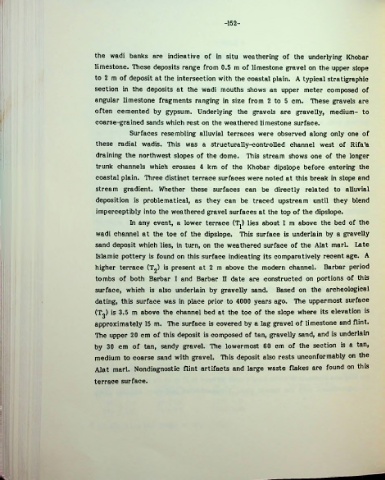Page 176 - Life & Land Use on the Bahrain Islands (Curtis E Larsen)
P. 176
-152-
the wadi banks are indicative of in situ weathering of the underlying Khobar
limestone. TTiese deposits range from 0.5 m of limestone gravel on the upper slope
to 2 m of deposit at the intersection with the coastal plain. A typical stratigraphic
section in the deposits at the wadi mouths shows an upper meter composed of
angular limestone fragments ranging in size from 2 to 5 cm. These gravels are
often cemented by gypsum. Underlying the gravels are gravelly, medium- to
coarse-grained sands which rest on the weathered limestone surface.
Surfaces resembling alluvial terraces were observed along only one of
these radial wadis. This was a structurally-controlled channel west of Rifa'a
draining the northwest slopes of the dome. This stream shows one of the longer
trunk channels which crosses 4 km of the Khobar dipslope before entering the
coastal plain. Three distinct terrace surfaces were noted at this break in slope and
stream gradient. Whether these surfaces can be directly related to alluvial
deposition is problematical, as they can be traced upstream until they blend
imperceptibly into the weathered gravel surfaces at the top of the dipslope.
In any event, a lower terrace (T^) lies about 1 m above the bed of the
wadi channel at the toe of the dipslope. This surface is underlain by a gravelly
sand deposit which lies, in turn, on the weathered surface of the Alat marl. Late
Islamic pottery is found on this surface indicating its comparatively recent age. A
higher terrace (T2) is present at 2 m above the modern channel. Barbar period
tombs of both Barbar I and Barbar n date are constructed on portions of this
surface, which is also underlain by gravelly sand. Based on the archeological
dating, this surface was in place prior to 4000 years ago. The uppermost surface
(Tg) is 3.5 m above the channel bed at the toe of the slope where its elevation is
approximately 15 m. The surface is covered by a lag gravel of limestone and flint.
Tlie upper 20 cm of this deposit is composed of tan, gravelly sand, and is underlain
by 30 cm of tan, sandy gravel. The lowermost 60 cm of the section is a tan,
medium to coarse sand with gravel. This deposit also rests unconformably on the
Alat marl. Nondiagnostic flint artifacts and large waste flakes are found on this
terrace surface.

